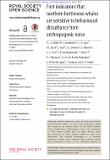First indications that northern bottlenose whales are sensitive to behavioural disturbance from anthropogenic noise
Abstract
Although northern bottlenose whales were the most heavily hunted beaked whale, we have little information about this species in its remote habitat of the North Atlantic Ocean. Underwater anthropogenic noise and disruption of their natural habitat may be major threats, given the sensitivity of other beaked whales to such noise disturbance. We attached dataloggers to 13 northern bottlenose whales and compared their natural sounds and movements to those of one individual exposed to escalating levels of 1–2 kHz upsweep naval sonar signals. At a received sound pressure level (SPL) of 98 dB re 1 μPa, the whale turned to approach the sound source, but at a received SPL of 107 dB re 1 μPa, the whale began moving in an unusually straight course and then made a near 180° turn away from the source, and performed the longest and deepest dive (94 min, 2339 m) recorded for this species. Animal movement parameters differed significantly from baseline for more than 7 h until the tag fell off 33–36 km away. No clicks were emitted during the response period, indicating cessation of normal echolocation-based foraging. A sharp decline in both acoustic and visual detections of conspecifics after exposure suggests other whales in the area responded similarly. Though more data are needed, our results indicate high sensitivity of this species to acoustic disturbance, with consequent risk from marine industrialization and naval activity.
Citation
Miller , P , Kvadsheim , P H , Lam , F P A , Tyack , P L , Curé , C , De Ruiter , S L , Kleivane , L , Sivle , L D , van IJsselmuide , S P , Visser , F , Wensveen , P J , von Benda-Beckmann , A M , Martin Lopez , L M , Narazaki , T & Hooker , S K 2015 , ' First indications that northern bottlenose whales are sensitive to behavioural disturbance from anthropogenic noise ' , Royal Society Open Science , vol. 2 , no. 6 , 140484 . https://doi.org/10.1098/rsos.140484
Publication
Royal Society Open Science
Status
Peer reviewed
ISSN
2054-5703Type
Journal article
Description
Contributions of P.M., P.T., C.C., S.D., F.V., P.W., L.M.L., T.N. and S.H. were funded by the US Office of Naval Research. Contributions of P.K., L.K. and L.S. were funded by the Norwegian Ministry of Defence. Contributions of F.L., S.v.IJ. and A.v.B. were funded by The Netherlands Ministry of Defence. Fieldwork contributions of L.M.L. and T.N. were funded by the Strategic Environmental Research and Development Program (SERDP). The analysis component of L.M.L.'s contribution was funded by DGA French Ministry of Defence. P.T. acknowledges the support of the MASTS pooling initiative (The Marine Alliance for Science and Technology for Scotland) in the completion of this study. MASTS is funded by the Scottish Funding Council (grant no. HR09011) and contributing institutions.Collections
Items in the St Andrews Research Repository are protected by copyright, with all rights reserved, unless otherwise indicated.

